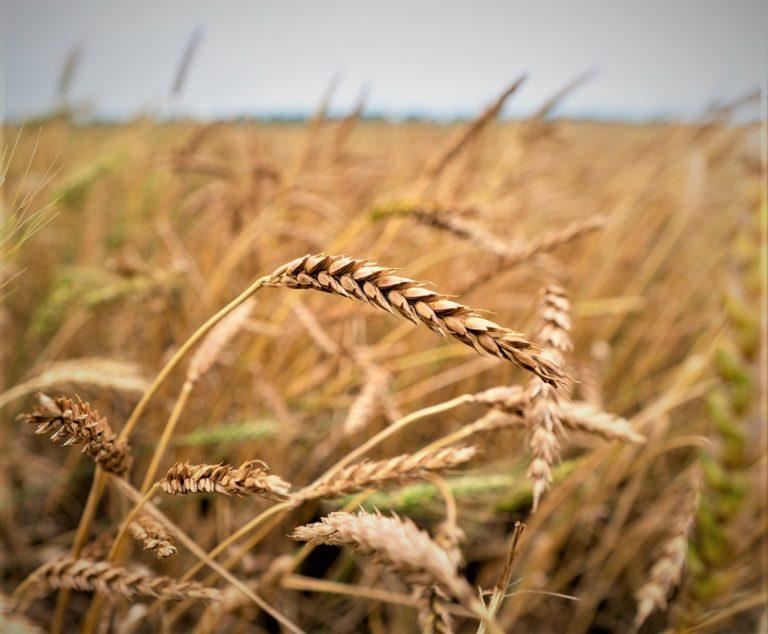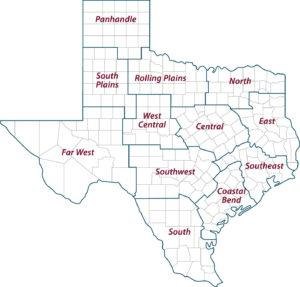Circumstances are improving for Texas grain producers as spring plantings get underway in southern parts of the state, according to a Texas A&M AgriLife Extension Service expert.
Mark Welch, Ph.D., AgriLife Extension grain market economist, Bryan-College Station, said strong grain prices, improving planting conditions and lower input costs are likely to encourage producers going into the season.
Welch said soil moisture conditions have improved across much of the state. Some areas in Central Texas, the South Plains, Rolling Plains and Panhandle remained severely to exceptionally dry, but widespread rains have improved conditions for two-thirds of the state, according to the U.S. Drought Monitor.

Many Texas grain producers are expected to graze wheat and follow with corn or cotton, but improved growing conditions and good prices could mean more farmers take their wheat to grain. (Texas A&M AgriLife photo by Laura McKenzie)
Some parts of East Texas and South Texas are dealing with excessive rain. Welch said AgriLife Extension agents in the Coastal Bend reported growers were eager to plant corn but that soggy fields are delaying equipment access.
“I do think the moisture improvement favors grain production,” he said. “Some areas need more rain before planting, but most producers are going to plant grain or cotton depending on their rotation schedule. It’s good for growers to have options and moderated input costs creates more room for potential profit.”
Options, outlook improves for Texas grain producers
The U.S. Department of Agriculture will release its early corn acreage estimate soon, Welch said. The expected acres report is based on modeling and limited survey information from growers and economists.
Welch suspects Texas corn acres could increase but said overall market and growing conditions give growers other options. Budgets will be tight, but lower costs for inputs like fuel and fertilizer have increased optimism among growers.
Welch said the cost for 130 pounds of nitrogen fertilizer is $20-$30 lower than this time last year. There are also fewer concerns about fertilizer availability.
The improved circumstances also give producers who planted winter wheat a number of options, he said. Texas farmers have planted the most wheat acres in 30 years. Parts of the state have remained dry and some acres may have failed due to poor germination, but those that emerged and hung on may begin flourishing with warmer temperatures on the horizon.
Producers planted wheat for various reasons – as a winter forage, cover crop, for grain or a combination of those reasons, Welch said. Wheat’s forage value is extremely high due to a short hay supply across the state. Fields could be grazed, baled or chopped for wheatlage and followed with crops like corn or cotton.
Another multi-cropping option is to produce or provide forage for cattle until mid-March and then take the crop to grain harvest in June or July. They could then follow wheat with a short-season sorghum or soybeans, he said.
“There was a lot of wheat planted in areas that don’t typically plant wheat, so they probably won’t go to grain,” he said. “But they may get some income or benefits from it as a forage.”
Grain prices incentivize increased production
Grain prices remain historically strong despite declining from record highs in 2022, Welch said.
Wheat cash prices are still over $8 per bushel – $8.84 per bushel for the northern Panhandle this week. Cash prices peaked over $12 per bushel after Russia invaded Ukraine last spring. In late summer 2020, the cash price of wheat in Texas was below $4 per bushel.
Corn prices are also relatively strong – right around $8 per bushel – compared to just below $3.50 in summer 2020. Cash corn was just below $9 per bushel last summer.
Welch’s only concern for all grains is that better growing conditions and price incentives could translate into more planted acres and higher yields that push supplies beyond demand. A slowing global economy could also tamp demand for grains.
Some mid-western grain-producing areas, especially western Kansas, continue to experience drought that could impact overall U.S. grain production. Production in Brazil, which is expected to be the world’s largest exporter of corn, could also impact prices. Harvest time of Brazil’s second season corn crop coincides with much of Central Texas.
“It’s a big old world, and the competition is growing,” he said. “Weather will be the big factor for everyone and determine supply, but record yields and an economic slowdown could dampen pricing opportunities.”
AgriLife Extension district reporters compiled the following summaries:
CENTRAL
Some moisture was received, followed by very high winds. Soil moisture was mostly adequate. Temperatures fluctuated from the 40s-70s with nighttime temperatures reaching below freezing. Overall rangeland and pasture conditions were poor. Livestock were in fair condition and received heavy rations of supplemental feed. Producers were preparing for spring planting with some already planting corn. Wheat and oats were in fair condition after the recent moisture.

A map of the 12 Texas A&M AgriLife Extension districts.
ROLLING PLAINS
A round of rain moved through providing trace amounts up to more than 1 inch of moisture to parts of the district. Wheat was starting to grow with some warmer temperatures, but grass and pastures remained dormant. Wheat conditions were poor to fair but improving. There was very little farming activity. Cattle were being fed cake and minerals, and some were being turned out on wheat pastures. Cattle were looking better and chasing green winter grasses.
COASTAL BEND
Temperatures warmed some. The soil dried out rapidly due to the warmer conditions and drier weather. A few areas still had water standing in the fields. Fieldwork increased given the drier conditions. Producers began planting corn and grain sorghum or fertilizing fields to prepare for planting. Rangeland and pasture conditions improved. Grass growth was expected to pick up with warmer temperatures and good moisture. Livestock producers continued supplementing animal diets with hay and protein, but feedings were tapering off as grazing conditions improved. Livestock remained in good condition, and some cows were starting to calve.
EAST
The district received heavy amounts of rain over recent weeks. Subsoil and topsoil conditions were adequate to surplus. Some parts of the district were completely soaked. Pasture and rangeland conditions were poor to good. Ponds and creeks were full. Plants and trees began to green up and bloom. Temperature fluctuations have been tough on crops and livestock. Hay supplies continued to run short for many producers. Livestock were in fair to good condition with supplementation taking place.
SOUTH PLAINS
Trace amounts of rain fell, but high winds dried the topsoil. Heavy winds were in the forecast. Producers continued to prepare fields for warm-season crops and water the winter wheat. Crop fields, pastures, winter wheat and oats needed moisture. Cattle were in good condition.
PANHANDLE
Dry conditions persisted across the district. Soil moisture was very short to short. Very little farming activity was reported. High winds caused a lot of dust in the air and damaged some wheat fields with marginal stands. Rangeland and pasture conditions were very poor to poor. Cattle on rangeland were being supplemented.
NORTH
Soil moisture was short to adequate across the district. Heavy rainfall left some pastures soaked and muddy. Some sunshine would help grazing conditions amid the hay shortage. Wheat conditions were below normal due to the recent winter freeze. Hay was still in high demand. Livestock conditions were good. No insect or disease outbreaks were reported.
FAR WEST
Weather conditions ranged from very wet and icy conditions at the beginning of the week to 80-degree days midweek followed by another cold front. Rains were localized and many areas received trace amounts to nothing. Conditions in the Davis Mountains were extremely windy and cold with gusts of up to 80 mph, and low temperatures in the teens. Sustained winds of 40 mph were reported around the district. Wheat was starting to joint but was showing moisture stress. The few wheat acres being irrigated looked decent and may be taken to harvest amid attractive prices. Fieldwork slowed except for growers going over fields to prevent the topsoil from blowing away due to high winds. Pre-watering began for a few growers and will significantly increase in coming weeks. Pastures were bare except for a few weeds in low spots. Livestock were in poor to fair condition, and supplemental feeding continued. No major damage from freezing temperatures was reported, but conditions were hard on livestock during lambing.
WEST CENTRAL
Pastures were greening up and creating some grazing for livestock. High winds dried the topsoil some. Wheat and oats continued to grow and provided some grazing, while oats in some locations were not expected to recover from the extreme cold in December. Many farmers were talking about sprigging some Coastal Bermuda grass this spring if it continues to stay wet. Local cattle prices were up significantly for feeders. There were also a few more small herd liquidations as drought conditions and lack of hay force selloffs. Some field preparation for Sudan grass planting continued.
SOUTHEAST
Temperatures were warmer and pastures were greening up. Soil moisture was adequate to surplus following recent rains. Growing conditions were favorable for winter forages. Rangeland and pasture conditions were very poor to excellent. Improved grazing conditions translated into higher calf prices at local markets. Fieldwork was delayed due to excessive rains. Rice fields need to dry enough for planting next month. Some fields were drying some due to a break in the rain and sunny, windy conditions.
SOUTHWEST
No precipitation was reported. Temperatures were warmer before a strong cold front brought cooler temperatures and gusty winds. Corn planting was expected to start soon. Farmers finished fertilizing in preparation of planting. Oats and wheat looked better following rains in the past few weeks. Pastures continued to improve, but more spring rains will be needed for recovery. Supplemental feeding of livestock continued. Cattle prices were steady to high.
SOUTH
Soil moisture conditions were very short to adequate. Temperatures were cooler with windy conditions reported in some areas. Producers were preparing fields for spring crops. Some producers started planting corn according to soil moisture levels in fields. Most growers were expected to wait for rain over the next two weeks. Some planted fields germinated but were stressed by high winds. Crops under irrigation continued to progress. Growers with irrigation were planting corn, sorghum and sunflowers. Corn plantings were complete in some areas. Citrus, onions, sugarcane and cool-season vegetables were being harvested. Some late-planted onions were being irrigated. Rangeland and pasture conditions were very poor to fair. Conditions were improving in some areas but continued to decline in most areas. Wildfires were a concern in areas with standing grasses. Supplemental feeding continued for livestock, and body conditions were good. Prices for feed, hay and supplements continued to increase. Some producers continued to cull their herds. Beef cattle prices were steady to higher with above-average sale volumes. Landowners continued to provide wildlife with supplemental food.
Source : tamu.edu